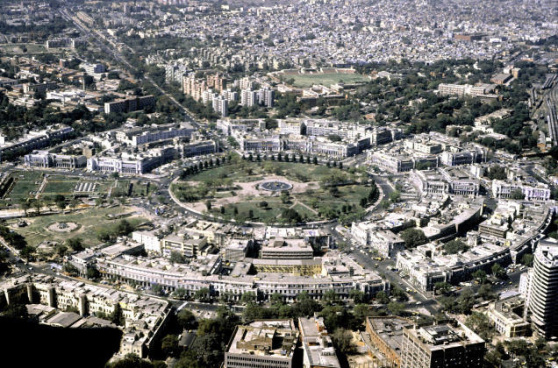
In the midst of the numerous challenges we face today, ranging from pandemics to geopolitical tensions, it is sometimes easy to overlook the long-term threat that has quietly loomed in the background for decades – climate change. Whenever we broach the subject of climate change, we invariably zoom in on greenhouse gas (GHG) emissions. These emissions thrust cities into the spotlight of our discussions. We are well aware that cities, those bustling, chaotic, and often contentious epicenters of human civilization, contribute significantly to global carbon emissions. Yet, cities are also beacons of hope for disrupting the status quo. They are not only centers of prosperity and innovation but also have the potential to address challenges effectively, provided that state, central governments, and expert agencies collaborate to enhance their financial and technical capabilities through multilateral cooperation arrangements.
The All India Institute of Local Self- Government (AIILSG), established in 1926, in partnership with the Global Covenant of Mayors for Climate and Energy and several other organizations, is actively assisting cities in bolstering their capacities and facilitating access to climate finance. AIILSG, as the Networking and Governance Coordinator of GCOM South Asia, is assisting 48 signatory cities spread across various countries in South Asia.
The Urbanisation Paradox
Cities, by their very nature, have gained notoriety as contributors to climate change. They consume copious amounts of energy, emit greenhouse gases, and encroach upon natural habitats. However, they also serve as essential engines of economic growth, innovation, and cultural exchange. This intricate, often contradictory relationship holds the potential for transformation.
South Asia, home to some of the world’s most populous and rapidly urbanizing nations, serves as the ideal laboratory for studying this paradox. Take India, for instance, where urban areas are projected to house two-thirds of the population by 2050. Here, the urbanization challenge is akin to constructing a new city the size of Chicago annually for the next three decades, as indicated in a report from a prominent consulting firm. It’s an immense endeavor fraught with both peril and promise.
So, how can we harness this wave of urbanization as a force for good in the battle against climate change? The answer lies in resilience – the capacity of cities to withstand shocks and adapt to changing circumstances.
First and foremost, resilient urban economies necessitate robust infrastructure. This extends beyond mere concrete and steel; it encompasses intelligent, sustainable, and adaptable systems. From energy grids powered by renewables to efficient public transportation, the foundational elements of a resilient city must be future-ready. Singapore, often lauded as a model of urban planning, epitomizes this approach. They have transformed a small, resource-scarce island into a global business hub while making substantial investments in green infrastructure. Rooftop gardens, rainwater harvesting, and efficient waste management systems have propelled the Lion City to the forefront of urban resilience.
Inclusivity is Key
Nevertheless, infrastructure alone is insufficient. Resilient cities must also prioritize social inclusivity. The benefits of growth should reach all citizens, rather than favoring a privileged few. Slums and informal settlements, common sights in South Asia’s megacities, pose not only humanitarian concerns but also vulnerabilities in the face of climate change.
Indian cities have been prioritizing policies that emphasise affordable housing, green spaces, and public transportation for all residents, ensuring that economic growth leaves no one behind. This serves as an example of how social equity and resilience can work in tandem. Many cities have received accolades for their efforts in enhancing civic services on a global scale. Although work remains ongoing, Indian cities that were not initially proactive for various reasons are now confronting challenges
head-on and devising solutions for their evolving and existing problems.
Innovation and Adaptation
Furthermore, resilient urban economies are characterized by innovation and adaptation. They tap into the collective brainpower of their residents to address local challenges.
In South Asia, Chennai’s response to water scarcity serves as a shining example. Confronting a severe water crisis, the city turned to decentralized rainwater harvesting systems and community-driven water management. Today, Chennai not only enjoys greater water security but also fosters a culture of innovation with far-reaching implications for other water-stressed cities.
None of these transformations are attainable without effective governance. City leaders must possess the vision to plan for the long term, the political will to make tough decisions, and the ability to collaborate with a diverse array of stakeholders.
Conclusion
While it is undeniable that our cities contribute to the climate problem, they also hold the potential to be central to the solution. Resilient urban economies are not a mere aspiration; they are a necessity.
Also Read | Innovation-Powered Resilient Cities The Youth at the Helm
Ultimately, the battle against climate change is a race against time. South Asia’s rapidly urbanizing cities play a pivotal role in this race. They serve as laboratories of innovation, engines of economic growth, and frontline defenders in the battle of adaptation. Therefore, let us not underestimate the power of cities to drive growth and recovery while also mitigating the impacts of climate change. As we peer into the future, let us embrace the paradox of urbanization, for within the heart of chaos lies the promise of resilience, and within our cities resides the hope for a sustainable future.
Views expressed by Abhishek Pandey, Editor, Urban Update, All India Institute of Local Self-Government





















